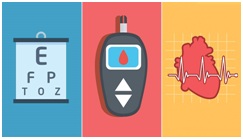Diabetic Retinopathy
Diabetic retinopathyis one of the leading causes of blindness in the world. Routine and regular eye examinations by your optometrist can significantly improve your chances of seeing clearly for many years to come. We recognize how important early detection is and our office has invested heavily in technology that allows us to detect diabetic eye disease before it starts to threaten your vision.
By usingthe lasting technology in digital imaging and OCT technology you can be assured we will be taking the best care of your vision.
What is diabetic retinopathy?
It is a condition that develops in your retina. The retina is a thin layer of tissue at the back of your eye, near the optic nerve. It has the vital role of receiving light and converting it into neural signals sent to the brain for visual recognition. The blood vessels in your retina can become damaged and over time your eyesight may become blurry and begin to disappear.
What causes diabetic retinopathy?
High blood sugar can damage the small vessels that supply blood to your retina and alter their structure and function. Due to this, the vessels can thicken, leak, develop clots or close off. In advanced cases, the blood flow can be blocked and your eye will attempt to fix the situation by growing new defective vessels. The new vessels are not as strong as the original ones and may leak or rupture and damage your vision further.
How is diabetic retinopathy diagnosed?
Your eye doctorusually starts by adding drops to your eyes that dilate your pupils. These drops may sting a little for a few seconds. Some patients describe the feeling similar to when you cut onions. The dilating drops allows for better inspection and detection of potential damage caused by the retinopathy inside of your eyes.
At our Mississauga and Brampton offices we will conduct the following tests allowing us to detect diabetic changes in your eye sooner.
Retinal Imaging
This procedure gives us a magnified and detailed “birds eye” view of your central retina. Not only is the image more magnified but it also allows us to look at the whole central retina in one view, giving us a more complete picture as to what exactly is going on behind your eyes. Routine retinal image screenings allow your eye doctor to detect even the smallest of changes earlier before they affect your vision thus saving your vision. Sometimes even more detailed information is required. Our optometry offices in Mississauga and Brampton are fortunate enough to have invested in a highly sophisticated piece of technology known as an OCT device.
Optical coherence tomography (OCT)
OCT technology is an imaging test using light waves to take detail cross sectional views of specific areas in your retina. Where as a retinal image gives your optometrist an “birds eye” view of your retina the OCT device allows us to see a cross-sectional view. When a retinal image picks up an area of concern, perhaps some early bleeding etc. Your eye doctor will then use the OCT to focus in on the finer details of your retina layers and find areas of increased thickness. This thickness is edema (swelling) caused by bleeding. If this bleeding/swelling is sight threatening further intervention/treatment may be required. OCT testing does not take very long usually just about 2-3 minutes in total but gives us a treasure trove of information on your eye health.
Preparing for your eye exam
It can be helpful to note down your symptoms and what your blood glucose levels are when they occur; write down other health issues you’re experiencing, when they occur, and what makes them stop; finally, write down any questions you may have and do not forget to bring an list of your medications.
How often should people with diabetes have an eye exam?
People with either Type 1 or 2 Diabetes should have their first eye exam as soon as they are diagnosed establishing a good baseline including retinal imaging. Thereafter it is important to have an annual eye exam since people with diabetes are in a particularly high-risk group for developing retinopathy and loss of vision.
Why is it important for diabetics to have a diabetic eye exam?
People with diabetes are in a higher risk group for developing eye complications. The longer you have the disease, the higher the risk. Early stages of diabetic retinopathy can be symptomless and you may not notice a change in your vision. It’s only possible to detect the problem with an eye exam. With regular checkups, your eye doctor stands the best chance of catching the symptoms early on. With an early diagnosis, your eye doctor can come up with a diabetic retinopathy treatment plan to prevent the retinopathy from getting worse and preserve your sight for as long as possible.
What is the best treatment for diabetic retinopathy?
The best treatment is regular monitoring, early diagnosis and timely treatment. At our Mississauga and Brampton offices, we are fully equipped to diagnose and detect irregularities in your eyes in a timely manner and offer diabetic retinopathy treatment based on our 20-year experience.





